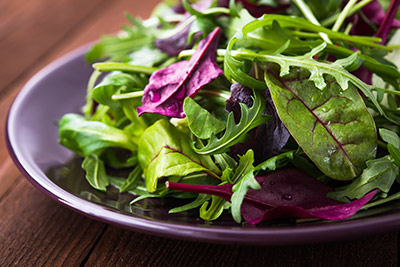 Greens are high on the list of nature’s most beneficial foods, offering a great nutrition source per calorie. That’s why one of easiest ways to eat healthy is to eat your greens!
Greens are high on the list of nature’s most beneficial foods, offering a great nutrition source per calorie. That’s why one of easiest ways to eat healthy is to eat your greens!
Stick with the Leaves
Green plants have long been recognized by food and nutrition researchers for bringing plenty of health benefits—and with very little caloric impact. That’s why extra veggies are a favorite go-to for lean athletes and fitness buffs alike. Some dietary experts recommend seven to nine cups of produce per day, with three of them coming from leafy greens.
Not everyone can imagine taking in that much vegetation, but for most healthy people, eating just a serving or two of greens daily could bring a whole new level of nutrition to their plates—plates overflowing with mineral-rich and antioxidant-packed plant food.
When we talk about leafy greens, or even spring greens (since a lot of the greens are in prime growing time in the spring), we’re literally speaking of the leaves of plants. A list of the most common greens you might find in the produce aisle includes:
|
|
|
Green Power
There are so many potential benefits to eating your greens: they are convenient (grab, wash and eat), fibrous (extra important if you’re not eating grains) and nutrient-dense, especially when it comes to certain minerals that can be hard to get from other foods. The power of greens is multiplied as a source of calcium, potassium and magnesium.
Calcium: It’s a mistake to ignore the need for calcium, which is a building block for bones, required for muscle contraction, and an essential trigger for transmitting messages through your nervous system. You can supplement this mineral easily enough, but natural foods are always the preferred source for the daily value (DV) of 1000 mg for adults. If you don’t eat dairy, leafy greens are among your best choices.
- 1 cup of cooked collards delivers 266 mg of calcium (appr. 25% DV)
Potassium: You’ve probably heard that tubers (like potatoes) are a good source of potassium, but greens rank right up there, too. An intense workout tends to suck a lot of potassium from your system—along with calcium, it’s key to muscular energy. The daily value recommended for adults is 3500 – 4700 mg. Another critical role of potassium in the diet is its partnership with sodium to regulate blood pressure.
- 1 cup of cooked spinach delivers 840 mg of potassium (appr. 20% DV)
Magnesium: One of the most important minerals is magnesium. Amazingly, more than 300 processes in the human body rely on magnesium, including the production of ATP which supplies your cells to make energy. It’s tough to get enough dietary magnesium without supplementing (women should try for 320 mg, and men aim for 420 mg). Eating your greens will go a long way toward optimizing your nutritional intake.
- 1 cup of cooked chard delivers 150 mg of magnesium (appr. 35 – 45% DV)


